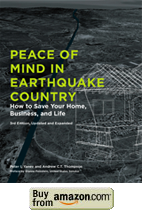THE RISKS OF NEW TALL REINFORCED CONCRETE BUILDINGS
One of the developments of the real-estate bubble of the first decade of the 21st century is the construction of tall reinforced concrete buildings in regions of high earthquake hazard. Until recently, almost all tall buildings in earthquake regions of the United States were built of structural steel. Most of these were also commercial buildings.
Tall reinforced concrete buildings are now the norm for residential construction such as condominium towers. Many are slender, seemingly all glass buildings with panoramic views uninterrupted by structural elements such as columns and shear walls. Some of these new residential towers rely on a substantial concrete shear-wall core to provide earthquake resistance. In effect, these buildings resemble in their overall design a tall industrial concrete stack or chimney, surrounded by columns and enclosed by glass.
There are three reasons for concern regarding the earthquake safety of these buildings. The first concern is that U.S. building code requirements for earthquakes were not developed and written for application to tall buildings (say over 20 stories). Prescriptive rules in the code are based around the dynamic behavior of low- and medium-rise structures, not the more complex dynamic behavior of tall buildings. If the code procedures are followed blindly, and low- to medium-rise building analysis and design procedures are used for high-rise construction, the result can be a building that is more vulnerable than that anticipated by the codes. It is essential that tall buildings be designed by highly qualified structural engineers (as many of them are), and that the appropriate earthquake hazard assessment, structural analysis, testing, and peer review be performed. This concern has recently been recognized by the regulatory authorities in San Francisco and Los Angeles, for example, where the need for advanced methodologies for designing high-rise buildings is now recognized.
The second issue is the potential lack of redundancy in the structural system. The same structural elements that are intended to absorb the earthquake energy (the shear walls) are also primary gravity-supporting elements. If the shear wall fails due to unexpected loading or unanticipated structural behavior, there is no second line of defense to prevent the tower from collapsing.
The third issue is our lack of experience with the behavior of these tall concrete buildings in very long and large earthquakes. Many capable engineers and engineering professors have spent much time analyzing the buildings, and tests have been conducted at universities and elsewhere to understand their behavior. However, these studies are ongoing and unanswered questions remain. As none of our modern construction of any type has been tested under very strong ground motion (we have yet to experience a great earthquake in the mainland U.S. in modern times), we do not have the evidence to demonstrate the ultimate effectiveness of any new design and construction technique. After the authors’ visits to - and investigations of - more than 100 earthquakes around the world, however, we have learned that earthquakes do cause unexpected events do happen.
The upshot is that there are potential risks associated with tall concrete buildings. Their performance and safety is building-specific, they sometimes lack redundancy, and they embody unanswered questions and differences of opinion within the international earthquake engineering community. This is all underscored by the large numbers of people living and working in these buildings.
The other risk with these buildings, and particularly residential towers, is financial. The building codes are intended to provide life safety, not investment safety. In a very large earthquake, a building that meets the code and does not injure its occupants may be a total loss because of structural damage that is, in effect, allowed by the code. That is not what most investors want; it is also something that most investors do not understand.
Contrary to most buyers’ expectations, apartments in such buildings are much higher financial risks than ordinary (relatively new) houses.
If you are considering investing, working, or especially living in one of these buildings, we recommend that you first do your research, including seeking the advice of a highly qualified structural engineer who is familiar with the design of tall buildings in California or Japan. The engineer should not have been involved in the design or review of the building in question. The engineer should be totally independent.
